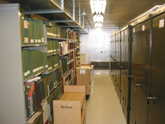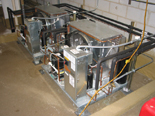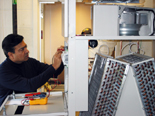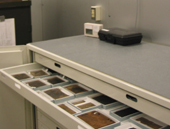
Preserving the Western Hemisphere’s largest papyrus collection is a monumental refrigeration retrofit engineering task at the University of Michigan’s Harlan Hatcher Graduate Library, Ann Arbor, Mich. Shannon Zachary, head of library preservation at University of Michigan, specified very tight set point condition tolerances of 65°F (±1°F) and 45 percent relative humidity (±4 percent) to preserve the ancient papyrus writings. (Photo courtesy of University of Michigan archives.)
Many archivists agree that state-of-the-art archival storage environments and standards are possible today thanks to evolving advancements of HVAC high technology the past 15 years, but that energy-efficient and environmentally-friendly systems are considered the next frontier.
“There seems to be a lot of interest in green systems and we’re starting to see the subject listed in conference seminar programs now,” said Shannon Zachary, head of preservation, University Library-University of Michigan, Ann Arbor, Mich.
Preserving the Western Hemisphere’s largest papyrus collection - ancient writings on fragile papyrus reeds dating back to 1000 B.C. that the University discovered during early 20th century archeological digs - in a constant temperature and humidity was a monumental mechanical engineering task. The difficulty was exacerbated by an additional quest for a green system, according to the system’s designer, Thomas Girard, manager of mechanical engineering in the University of Michigan Architecture Engineering & Construction Department. Zachary wrote the operational standard for the room, much of which is based on the Canadian Council of Archives’ “Conservation Environment Guidelines for Libraries and Archives,” by William Lull. Most importantly, Zachary established set point conditions of 65°F (±1°F) and 45 percent relative humidity (±4 percent), which mechanical engineers routinely accomplish with an oversized HVAC system that requires very low discharge air temperature for proper dehumidification (approximately 42°F) and a large quantity of reheat.

The original prefabricated room envelope that contains the papyrus collection, which consisted of metal skin walls with an excellent R-15 insulation value, was still in mint condition and didn’t need updating during the IAQ retrofit. (Photo courtesy of Joe Arnold, Computer Environments, Livonia, Mich., and Dectron Internationale, Roswell, Ga.)
DESIGNING A GREEN SYSTEM
Girard’s design was not only green in many ways, it also outlined so many strict tolerances that very few HVAC producers had factory capabilities to custom build them in a single unit. Girard and project mechanical contractor, James Dornbrock, Altech Mechanical, Ann Arbor, spent over a year designing the mechanical system, which was then custom manufactured by Ecosaire, a precision air conditioning manufacturing subsidiary of indoor air quality specialist, Dectron Internationale, Roswell, Ga.“Tom and I spent a lot of time with enthalpy charts and temperature/humidity calculations before we specified the equipment,” recalled Dornbrock.
“We selected Ecosaire because they were one of the few manufacturers that could deliver a unit to our strict specifications,” said Girard, who worked with manufacturer’s representative, Joe Arnold, general manager of Computer Environments Inc., Livonia, Mich., during the unit’s factory fabrication.
As per Girard’s specification, Ecosaire designed the system for the environmentally-friendly R-407C refrigerant, which is a HFC alternative refrigerant to the current chlorine-based HCFC refrigerant standard of R-22. Most current archival room HVAC systems use R-22 refrigerant, which is scheduled to be phased out of production and use in the next 12 years as part of the Clean Air Act.
Instead of over-sizing a one-compressor system to handle the room at full load, Girard specified a dual 1.5-ton parallel airflow compressor/condenser system that saves upwards of 50 percent of energy versus typical archival room systems.

Instead of a more conventional outdoor location where Michigan’s ambient air temperatures have wild swings of -10° to 95°F, University of Michigan engineer, Thomas Girard located the two air-cooled condenser coils in the library’s central HVAC penthouse mechanical room. The penthouse essentially is a flow-through relief exhaust plenum for the building. Thus the precision air conditioning system for the papyrus room operates more efficiently with its condensers subjected to the penthouse’s more constant temperature fluctuation of 65° to 85°F year-round. (Photo courtesy of Joe Arnold, Computer Environments, Livonia, Mich., and Dectron Internationale, Roswell, Ga.) (Click on the image for an enlarged view.)
Thanks to precise trend data Zachary provided regarding hours of occupancy, necessary temperature/humidity data, etc., combined with his own internal study of the room envelope characteristics, Girard was able to precisely size the main compressor to condition the room 95 percent of the time when it is unoccupied. In impromptu instances where a semi-monthly class or conference is held and the lighting is on, a second compressor activates to handle the extra load. The second compressor also provides the necessary redundancy. If one compressor fails, the other compressor activates and room access is limited until both compressors are operational again.
“Maintaining these tight tolerances is much easier with a compressor sized exactly to the load that runs 24/7,” explained Girard. “Oversized compressors that kick on two or three times every hour not only make tight tolerances difficult to meet, but they also use much more energy in the process. In unoccupied mode, air flowing through the inactive coil essentially serves as ‘free reheat.’ Less cooling is required since only half the air is subcooled for dehumidification. Virtually no additional reheat is required because the capacity of each compressor is closely matched to the continuous cooling load associated with fan heat.”
Girard also used heat recovery to guarantee tighter temperature tolerances. Instead of a more conventional outdoor location where Michigan’s ambient air temperatures have wild swings of -10°F to 95°F, Girard located the two air-cooled condenser coils in the library’s central HVAC penthouse mechanical room, which is conveniently one floor above the eighth-floor papyrus room’s 100-square-foot mechanical room. This mechanical penthouse shelters general building air handlers and also serves as a return exhaust plenum. Thus the two condensers are subjected to a relatively constant temperature of 65° to 85°F year-round because the penthouse acts as a flow-through relief exhaust plenum.
Exposure to the outdoor temperatures and the need for low ambient condenser dampers was one shortcoming of the original non-redundant, single compressor/condenser, circa 1980’s conventional air conditioning system that serviced the room since its inception 20 years ago. Service access was also improved on the new condenser design.

Shewar Haque, P. Eng., manager of engineering & applied sales, Ecosaire by Dectron, Montreal, designed the custom precision air conditioning system and assisted project HVAC contractor, Altech Mechanical, Ann Arbor, Mich., with the installation and start-up. (Photo courtesy of Joe Arnold, Computer Environments, Livonia, Mich., and Dectron Internationale, Roswell, Ga.) (Click on the image for an enlarged view.)
A quick installation time was the least of Dornbrock’s worries, however. Zachary’s list of prohibited construction materials - mainly chemicals such as formic acid (oil-based paints), formaldehydes (duct tape adhesives), polyvinylchloride (piping), oil based compounds (pipe thread sealant/lubricants), acid-cured silicone caulking - turned Dornbrock into an amateur chemist to find materials compatible with the room’s sensitive archives.
Working in the project’s favor, however, was the fact the original prefabricated room envelope, which consisted of metal skin walls with an excellent R-15 insulation value, was still in mint condition and didn’t need updating. The room’s existing supply ductwork was used as well and its linear diffusers provide a very even airflow.
“We wanted to minimize construction work inside of the room so as not to upset temperature and humidity levels,” said Girard.
The project also includes four critical air purification stages - a 30 percent pleated filter, 95 percent pleated filter, gas-phase charcoal filtration, and a post gas-phase pleated filter to catch any charcoal dust, to help eliminate any infiltration of harmful airborne contaminants into the room.

The ancient writings on fragile papyrus reeds, which date back to 1000 B.C. and were found by university researchers during early 20th century archeological digs, require a constant temperature and humidity that is supplied by an Ecosaire by Dectron precision air conditioning system. (Photo courtesy of Joe Arnold, Computer Environments, Livonia, Mich., and Dectron Internationale, Roswell, Ga.)
“There is nothing like this precision air conditioning unit on the market,” noted Arnold, who said Ecosaire is planning to take the design and mass market it to the preservation field especially since Dectron can provide all the components ranging from air conditioning, air purification, dehumidification, and humidification in-house and factory engineer them into one package unit for convenient single-source responsibility.
The unit is interfaced with the university’s Siemens Building Technologies Inc. (Buffalo Grove, Ill.) campus-wide building automation system and monitored.
Zachary also keeps a close watch on the room even when off-campus via a Sensaphone Inc. (Aston, Pa.) IMS-4000, which monitors data 24/7 and sends alarms remotely to her home. The Ecosaire equipment can also communicate with facility or service personnel via TCP/IP, Modbus™, Echelon®, Bacnet®, or Lonworks®-based building management systems.
Another IAQ tool in the room is the Preservation Environment Monitor (PEM), a temperature and rh recorder/monitor by the Image Permanence Institute (IPI), a non-profit research laboratory based at the Rochester University, Rochester, N.Y., that is devoted to scientific research in the preservation of visual and other forms of recorded information.
With Girard and Dornbrock’s design and Zachary’s attention to detail, it’s a guarantee that the University of Michigan’s priceless papyrus writings collection will remain in a good environment.
Publication date:03/10/200

Report Abusive Comment